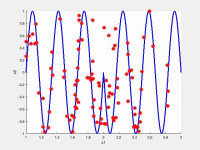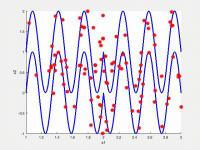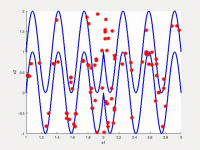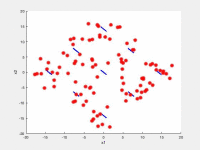Research Blog
Multi-Objective Multi-Modal Optimization
Multi-objective Optimization Problems (MOPs) have typically several conflicting objectives which are supposed to be optimized at the same time. The solution of such problems is a set of so-called Pareto-optimal solutions. In our research in the area of Multi-Modal Multi-Objective Optimization we work on a particular sort of MOPs, namely Multi-Modal problems, which are present in many real-world problems. In such Multi-Modal problems, multiple equivalent solutions map to the same Pareto-optimal solution. The major challenge for the optimization algorithms is to discover these several equivalent solutions in the decision space. In our research we work on a variety of approaches to address this issue. In one of our recent works, we propose a new algorithm NxEMMO which enforces the diversity of the solutions in decision-space:
- Mahrokh Javadi and Sanaz Mostaghim
- Using neighborhood-based Density Measures for Multimodal Multi-Objective Optimization
- Accepted at the 11th International Conference on Evolutionary Multi-Criterion Optimization (EMO 2021), Shenzhen, China, 2021
In the following videos, the evolution of the population is shown in the search space for NxEMMO (left videos) and NSGA-II (right videos) as a baseline algorithms. The obtained solutions are shown as red stars, and the blue lines indicate the true Pareto-optimal solutions.


NxEMMO (left), NSGA-II (right)
Decision space for MMF1 test problem


NxEMMO (left), NSGA-II (right)
Decision space for MMF6 test problem


NxEMMO (left), NSGA-II (right)
Decision space for SYM-PART-Rotated test problem
Reliability of simulated swarms
We offer two studies covering findings about a simulation of reliability in organized animats. Animats are simple agents with cognitive abilities similar to organisms, e.g., ants or bees. We simulate the evolution of organized animal swarms navigating between two rooms without colliding against each other. These studies help to advance knowledge about the optimal size of organizations and how the organization's performance depends on the abilities of the individual members.

A sample animat configuration with basic cognitive abilites
Simulating agents acting in an organized group is already a common practice. Not only to study swarm behavior but also to solve optimization problems. Still, little is known about how the size of the group, the cognitive abilities of the agent, or uncertain environmental conditions influence behavior. Consequently, depending on the internal and external constraints, the behavior of agents and their ability to cooperate varies.

A sample Markov Brain using Hidden Markov Gates
In the simulation experiments, we are wondering about the specific size of the organization in terms of the number of individual members. As a second dimension, we manipulate the individual's potential skills in terms of memory, sensory capacity, or motoric abilities during evolution. After evolving the animats, we expose them with uncertain conditions like changing the group size or changing the static environment. Since the environment has constant space, changing the group size varies the environment's density, and the animats are less or more likely to meet group members. Changing the static environment makes it easier or harder to navigate between the rooms, e.g., by adding or removing walls. We argue that those post-evolutionary tests provide data to assess the reliability of animats under uncertain conditions. The abstract nature of our study can be useful to theorize about the dynamics between the organizational and individual levels. Further, it sheds light on the high complexity of studies investigating multiple levels of analysis.

The simulation of a winner generation, visualizing the wall-following strategy.
The findings are divided into the results for the evolution of the animats and the results of the reliability assessment: First, we find that it is dependent on the group size for animats to evolve flexible behavior, reasonable task fitness, and higher brain complexity. For our experiment design, the group size must be neither too small or too large. Second, we find that there can be a relationship between the group size an animat evolves in and the corresponding reliability. In our design, an animat who evolves in a balanced group size shows the best reliability under uncertain conditions. Further, we can show a correlation between high brain complexity, the group size, and optimized sensor capacity.
The evolutionary simulation experiments using a Genetic Algorithm to generate collective behavior. This method visualizes a way to study reliability in organized groups while being able to control conditions and collect data on multiple levels. In general, the studies show that the group size can have an effect on reliability in uncertain conditions and that rather general cognitive abilities, which relate to heuristics, can avoid over-specialization.
More details about this work can be found in:
- Fischer, D., Mostaghim, S., & Albantakis, L. (2020). How cognitive and environmental constraints influence the reliability of simulated animats in groups. PLOS ONE, 15(2), e0228879. https://doi.org/10.1371/journal.pone.0228879
- Fischer, D., Mostaghim, S., & Albantakis, L. (2018). How swarm size during evolution impacts the behavior, generalizability, and brain complexity of animats performing a spatial navigation task. GECCO 2018. https://doi.org/10.1145/3205455.3205646
Multi-Objective Pathfinding
Route planning, also known as pathfinding is one of the key elements in logistics, mobile robotics and other applications, where engineers face many conflicting objectives. However, most of the current route planning algorithms consider only up to three objectives. In our research, we work on many-objective pathfinding. In the following papers, we propose a scalable many-objective benchmark problem covering most of the essential features for routing applications based on real-world data. We define five objective functions representing distance, travelling time, delays caused by accidents, and two route-specific features such as curvature and elevation. Since this test benchmark can be easily transferred to real-world routing problems, we construct a routing problem from OpenStreetMap data (right video). More details can be found in our papers:
- Jens Weise and Sanaz Mostaghim
- Many-Objective Pathfinding based on Fréchet Similarity Metric
- Accepted at the 11th International Conference on Evolutionary Multi-Criterion Optimization (EMO 2021), Shenzhen, China, 2021
The first video shows one of our benchmark instances with a Lake-obstacle in the middle. During the video, the search of the paths is shown. The second video shows the same process on real-world data, the Berlin map.
And we just submitted the folowing paper:
- Jens Weise and Sanaz Mostaghim
- Scalable Many-Objective Pathfinding Benchmark Suite
- Submitted to IEEE Transactions on Evolutionary Computation.--> Link
Contour Search
Finding the contour of an object, known as contour search, has a large variety of applications. Beside the conventional applications in image processing, there are other applications in robotics. Imagine a scenario of identifying the contour of wildfire or oil spill on the ocean. The major challenges concern searching for an object and then identifying the corresponding contour. The existing algorithms typically rely on image processing technologies, which typically require knowledge about the entire search space. In our research, we work on a new algorithm for contour search which is based on Particle Swarm Optimization (PSO). We unify both of the search processes for the object and the contour identification in one algorithm. We consider the contour search of an object with an unknown shape which is located in an unknown position in a two-dimensional search space. Similar to optimization scenarios, the goal is to find and identify the contour (border) of any encountered part of the object. This research is being published in the following paper:
- Dominik Weikert, Sebastian Mai and Sanaz Mostaghim
- Particle Swarm Contour Search Algorithm
- Entropy, 22(4), 407, April 2020.https://doi.org/10.3390/e22040407 Open Access --> Link
Here are two videos on a sample test problem with both convex and concave contours:
Energy Model for Small-scale Flying Robots
Unmanned Aerial Vehicles (UAVs) are used in more and more applications in the real world. These applications range from inspection tasks, e.g., bridges and wind turbines to agriculture applications like protection of deer from harvesters. However, most of these applications are still done using remotely piloted UAVs, even though the usage of autonomous quadcopters as replacements promises additional benefits like tighter surveillance and less cost. Especially, swarms of UAVs promise high efficiency with low-cost UAVs. UAVs, in general, promise efficient deployment and manoeuvrability even in hardly accessible areas, for example, in natural disaster management. The benefit in manoeuvrability comes at the cost of high energy consumption of the robots. To create an optimal mission plan and take appropriate decisions during the mission, a reliable, accurate and adaptive energy model is of utmost importance. However, most existing approaches either use very generic models or ones that are especially tailored towards a specific UAV. We present a generic energy model that is based on decomposing a robotic system into multiple observable components. More details can be found here:
- Christoph Steup, Simon Parlow, Sebastian Mai and Sanaz Mostaghim
- Generic Component-based Mission-centric Energy Model for Micro-scale Unmanned Aerial Vehicles
- Drones, 4(4), 63, September 2020. https://doi.org/10.3390/drones4040063 Open Access --> Link
And here you see a video of our flying robot during the energy test:
Multi-Agent Path Finding
Robot swarms and multi-robot systems are very popular and are used in various applications. In most of such applications, navigation to certain positions and path planning for several robots within an environment pose a challenge for algorithm design. Currently robots rely on purely reactive behavior resulting in sub-optimal paths. The long term goal of our research is to extend the capabilities of the agents to plan future actions, taking into account the intend of their neighbors, to obtain more efficient behaviors. In order to optimally navigate within a moving robotic swarm, we need a framework for planning, evaluating and executing trajectories in a very dynamic environment. In the following paper, we propose a model to represent trajectories for multiple robots within a swarm, respecting the kinematic constraints of the robots given by a specific vehicle model.
- Sebastian Mai and Sanaz Mostaghim
- Modelling Pathfinding for Swarm Robotics
- In: Dorigo M. et al. (eds) Swarm Intelligence. ANTS 2020. Lecture Notes in Computer Science, vol 12421. Springer, Cham. 2020. https://doi.org/10.1007/978-3-030-60376-2_15
Swarm of Robots in Dynamic Environments
Since several years, we study the impact of dynamic environments (e.g., flow, wind) on robot swarms. This is actually a very important aspect, if we consider small scale (so called micro scale) robots which we have in our SwarmLab. Our flying robots are as large as an A4 paper and they are easily influenced by the wind in the back yard (where we do the outdoor experiments) or by themselves (since they fly in a swarm, they produce a lot of flow).
We have several works on this topic. The recent paper from 2020 is about various communication topologies. Here is the abstract of the paper and some interesting videos:
- Palina Bartashevich, Doreen Koerte and Sanaz Mostaghim
- Impact of Communication Topology on PSO-based Swarms in Vector Fields
- Accepted at the IEEE Symposium on Swarm Intelligence (SIS), SSCI, Australia, 2020
Abstract:
This paper studies the role of communication topologies in swarms performing the search under strong negative influence coming from the unknown external environment af- fecting the individuals’ movements. The experiments are carried out on two modified versions of PSO, namely Power- and Zigzag-PSO, which act without any preliminary information about external forces modeled by vector fields. We propose four dynamic topologies inspired by the game-theoretic concepts and investigate their performance relative to the ordinarily static ones with regard to convergence and “energy expenses”, reflecting the amount of collective effort needed to eliminate the produced drift. The results reveal that the topology of social connections on its own is not an effective way to cope with the unknown disturbance during the search. However, within the predefined coping mechanism against the disturbance as in the case of Zigzag-PSO, the considered dynamic topologies show the advantage before static ones for a limited communication radius, indicating its potential in swarm robotics applications.
Note in all of the videos, the swarm is performing a collective search to find a Point of Interest located at (-10,10). The Vector Fields (VF) show the different profiles. Radius refers to the communication radius.
New research blog
Welcome to our blog concerning the news about our research. You can always find the detailed information from our publications. This blog only provides the newest videos, codes and relevant short information.
